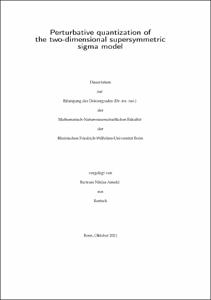Perturbative quantization of the two-dimensional supersymmetric sigma model

Perturbative quantization of the two-dimensional supersymmetric sigma model

| dc.contributor.advisor | Teichner, Peter | |
| dc.contributor.author | Arnold, Bertram Niklas | |
| dc.date.accessioned | 2022-03-15T11:10:55Z | |
| dc.date.available | 2022-03-15T11:10:55Z | |
| dc.date.issued | 15.03.2022 | |
| dc.identifier.uri | https://hdl.handle.net/20.500.11811/9677 | |
| dc.description.abstract | The two-dimensional nonlinear sigma model is a classical field theory whose fields are maps from a Riemann surface Σ to a Riemannian manifold X, and whose classical solutions are minimal surfaces. In this thesis, we study a supersymmetric extension, which has an additional fermionic field. Using a mathematical formulation of the Batalin–Vilkovisky formalism developed by Costello and Gwilliam, we show that a perturbative quantization of this sigma model on flat surfaces exists if and only if the first Pontryagin class p₁(TX) ∈ H⁴(X; ℂ) vanishes. If X is in addition closed and oriented, we rigorously define the partition function of the resulting quantum field theory and show that it defines a weak modular form of weight ½dim X. We calculate it exactly as the Witten genus.
The partition function is determined from local data on Σ through the factorization algebra structure on quantum observables, and we show that it is a deformation of a family of free quantum field theories. We prove existence of a quantization and calculate the partition function using a generalization of Gelfand–Kazhdan formal geometry to Riemannian manifolds, which reduces them to algebraic statements and Feynman diagram calculations. Our results are a first step in the Stolz–Teichner program for constructing geometric cocycles for elliptic cohomology. | en |
| dc.language.iso | eng | |
| dc.rights | In Copyright | |
| dc.rights.uri | http://rightsstatements.org/vocab/InC/1.0/ | |
| dc.subject | Perturbative quantum field theory | |
| dc.subject | deformation quantization | |
| dc.subject | factorization algebras | |
| dc.subject | elliptic cohomology | |
| dc.subject.ddc | 510 Mathematik | |
| dc.title | Perturbative quantization of the two-dimensional supersymmetric sigma model | |
| dc.type | Dissertation oder Habilitation | |
| dc.publisher.name | Universitäts- und Landesbibliothek Bonn | |
| dc.publisher.location | Bonn | |
| dc.rights.accessRights | openAccess | |
| dc.identifier.urn | https://nbn-resolving.org/urn:nbn:de:hbz:5-65686 | |
| ulbbn.pubtype | Erstveröffentlichung | |
| ulbbnediss.affiliation.name | Rheinische Friedrich-Wilhelms-Universität Bonn | |
| ulbbnediss.affiliation.location | Bonn | |
| ulbbnediss.thesis.level | Dissertation | |
| ulbbnediss.dissID | 6568 | |
| ulbbnediss.date.accepted | 28.01.2022 | |
| ulbbnediss.institute | Mathematisch-Naturwissenschaftliche Fakultät : Fachgruppe Mathematik / Mathematisches Institut | |
| ulbbnediss.fakultaet | Mathematisch-Naturwissenschaftliche Fakultät | |
| dc.contributor.coReferee | Stolz, Stephan | |
| ulbbnediss.contributor.gnd | 110542698X |
Files in this item
This item appears in the following Collection(s)
-
E-Dissertationen (4461)




